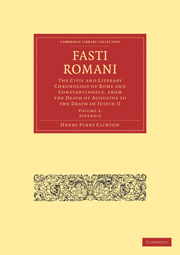 Fasti Romani
Fasti Romani 5 - SCRIPTURE CHRONOLOGY
Published online by Cambridge University Press: 03 May 2011
Summary
Before we enquire into the Gospel Chronology, it will be convenient to take a brief survey of the whole subject of Scripture Chronology as it is set forth in the first Volume of the Fasti Hellenici. It is there shewn that the Hebrew notation gives 1656 years from Adam to the Flood, and 352 from the Flood to the birth of Abraham; that 505 years are marked in Scripture from the birth of Abraham to the Exode; that from the Exode to the Temple were 612 years. Then followed the last 37 years of the reign of Solomon, and 389 from the death of Solomon to the destruction of the Temple, which happened in the 587th year before the Christian era. Reckoning upwards from this point, we obtain from these collected numbers B. C. 2130 for the birth of Abraham, B. C. 2482 for the Flood, and B. C. 4138 for the creation of Adam.
Mr. Cuninghame, whose laborious calculations and copious Tables are valuable aids to the student in Sacred Chronology, for all the time which follows the birth of Abraham, has preferred in the preceding periods the longer generations of the Septuagint, and places Adam at B.C. 5478 and the Flood at B.C. 3217. The chronology of Mr. Cuninghame has been adopted by Professor Wallace, who also accepts the longer computations of the Greek Version and rejects the numbers of the Hebrew Text; and has fully treated the subject in his dissertation on the True Age of the World. The arguments by which he has maintained his propositions shall in this place be briefly examined.
- Type
- Chapter
- Information
- Fasti RomaniThe Civil and Literary Chronology of Rome and Constantinople, from the Death of Augustus to the Death of Justin II, pp. 220 - 243Publisher: Cambridge University PressPrint publication year: 2010First published in: 1850


